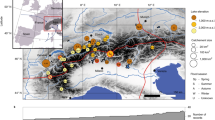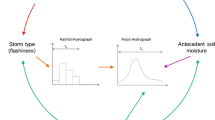Abstract
From 2009 to 2011, the Canadian Prairies were subjected to exceptionally variable precipitation regimes, ranging between record drought and unprecedented flooding. Adjacent regions concurrently experienced droughts and floods, and individual areas transitioned rapidly from pluvial to drought conditions and vice versa. Such events had major impacts; for example, damages from floods in the Assiniboine River Basin (ARB) have exceeded $1 billion, and forest fires ravaged the town of Slave Lake, Alberta. This study first characterizes, and then assesses, these devastating natural hazards in terms of their physical processes (across multiple spatial and temporal scales) related to both the spatially contrasting precipitation states and rapid temporal transitions between these states. Subtle differences in large-scale atmospheric flow had marked impacts on precipitation. Primary factors controlling the distribution and amount of precipitation included the location and persistence of key surface and upper-air features, as well as their interaction. Additionally, multiple events—rather than individual extremes—were responsible for the flooding over the Saskatchewan River Basin and the ARB. Very heavy rainfall events (≥25 mm d−1) accounted for up to 55 % of warm season rain at some locations, and the frequency of heavy rainfall events was critical for determining whether a region experienced drought or pluvial conditions. This study has increased our knowledge of the characteristics, impacts and mechanisms of rapidly transitioning disparate precipitation states on the Canadian Prairies and will aid in better understanding both past and projected future hydro-climatic extremes in the region.
















Similar content being viewed by others
References
Akinremi OO, McGinn SM, Cutforth HW (1999) Precipitation trends on the Canadian Prairies. J Clim 12:2996–3003
Benestad RE, Haugen JE (2007) On complex extremes: flood hazards and combined high spring-time precipitation and temperature in Norway. Clim Change 85:381–406
Bonsal BR, Wheaton EE, Chipanshi AC, Lin C, Sauchyn DJ, Wen L (2011) Drought research in Canada: a review. Atmos Ocean 49:303–309
Brimelow JC, Reuter GW (2005) Transport of atmospheric moisture during three extreme rainfall events over the Mackenzie River basin. J Hydrometeor 6:423–440
Burrows WR, Kochtubajda B (2010) A decade of cloud-to-ground lightning in Canada: 1999–2008. Part 1: flash density and occurrence. Atmos Ocean 48:177–194
Canadian Boreal Initiative (2013) http://borealcanada.ca/boreal-regions-e.php. Accessed 11 Oct 2013
Canadian Forest Service (2012) National Fire Database—Agency Fire Data. Natural Resources Canada, Canadian Forest Service, Northern Forestry Centre, Edmonton, Alberta. http://cwfis.cfs.nrcan.gc.ca/en_CA/nfdb/poly
Chung YS, Hage KD, Reinelt ER (1976) On lee cyclogenesis and airflow in the Canadian Rocky Mountains and the East Asian mountains. Mon Weather Rev 104:879–891
Evans E, Stewart RE, Henson W, Saunders K (2011) On precipitation and virga over three locations during the 1999–2004 Canadian Prairie drought. Atmos Ocean 49:366–379
Flannigan MD, Logan KA, Amiro BD, Skinner WR, Stocks BJ (2005) Future area burned in Canada. Clim Change 72:1–16
Flesch TK, Reuter RW (2012) WRF model simulation of two Alberta flooding events and the impact of topography. J Hydrometeor 13:695–708
Government of Manitoba (2012) http://news.gov.mb.ca/news/index.html?archive=2012-11-01&item=15561. Accessed 25 Jan 2013
Guttman NB, Hosking JRM, Wallis JR (1994) The 1993 Midwest extreme precipitation in historical and probabilistic perspective. Bull Am Met Soc 75:1785–1792
Hanesiak JM, Stewart R, Bonsal B, Harder P, Lawford R, Aider R, Amiro B, Atallah E, Barr A, Black T, Bullock P, Brimelow J, Brown R, Carmichael H, Derksen C, Flanagan L, Gachon P, Greene H, Gyakum J, Henson W, Hogg E, Kochtubajda B, Leighton H, Lin C, Luo Y, McCaughey J, Meinert A, Shabbar A, Snelgrove K, Szeto K, Trishchenko A, van der Kamp G, Wang S, Wen L, Wheaton E, Wielki C, Yang Y, Yirdaw S, Zha T (2011) Characterization and summary of the 1999–2005 Canadian Prairie drought. Atmos Ocean 49:421–452
Higgins RW, Silva VBS, Shi W, Larson J (2007) Relationships between climate variability and fluctuations in daily precipitation over the United States. J Clim 20:3561–3579
Insurance Bureau of Canada (2012) Telling the weather story. Final report, prepared by the Institute for Catastrophic Loss Reduction 2012, 67 pp
IPCC (2012) Managing the risks of extreme events and disasters to advance climate change adaptation. In: Field CB, Barros V, Stocker TF, Qin D, Dokken DJ, Ebi KL, Mastrandrea MD, Mach KJ, Plattner G-K, Allen SK, Tignor M, Midgley PM (eds) A Special Report of Working Groups I and II of the Intergovernmental Panel on Climate Change. Cambridge University Press, Cambridge, 582 pp
Junker NW, Schneider RS, Fauver SF (1999) A study of heavy rainfall events during the great Midwest flood of 1993. Weather Forecast 14:701–712
Kalnay E, Kanamitsu M, Kistler R, Collins W, Deaven D, Gandin L, Iredell M, Saha S, White G, Woollen J, Zhu Y, Chelliah M, Ebisuzaki W, Higgins W, Janowiak J, Mo KC, Ropelewski C, Wang J, Leetmaa A, Reynolds R, Jenne R, Joseph D (1996) The NMC/NCAR 40-Year Reanalysis Project. Bull Am Meteor Soc 77:437–471
Kempf NM, Krider EP (2003) Cloud-to-ground lightning and surface rainfall during the great flood of 1993. Mon Weather Rev 131:1140–1149
Kochtubajda B, Burrows WR, Liu A, Patten JK (2013) Surface rainfall and cloud-to ground lightning relationships in Canada. Atmos Ocean 51:226–238
Kunkel KE, Changnon SA, Angel JR (1993) Climatic aspects of the 1993 upper Mississippi River basin flood. Bull Am Meteorol Soc 75:811–822
Mahfouf J, Brasnett B, Gagnon S (2007) A Canadian Precipitation Analysis (CaPA) Project: description and preliminary results. Atmos Ocean 45:1–17
Mekis E, Hogg WD (1999) Rehabilitation and analysis of Canadian daily precipitation time series. Atmos Ocean 37:53–85
Parisien M-A, Peters VS, Wang Y, Little JM, Bosch EM, Stocks BJ (2006) Spatial patterns of forest fires in Canada, 1980–1999. Int J Wildland Fire 15:361–374
Phillips D (2010) Top 10 Canadian weather stories for 2009. CMOS Bull 38:18–24
Phillips D (2011) Top 10 Canadian weather stories for 2010. CMOS Bull 39:12–21
Phillips D (2012) Top 10 Canadian weather stories for 2011. CMOS Bull 40:12–22
Potop V, Boroneanţ C, Možný M, Štěpánek P, Skalák P (2013) Observed spatiotemporal characteristics of drought on various time scales over the Czech Republic. Theor Appl Climatol. doi:10.1007/s00704-013-0908-y
Reuter GW, Nguyen CD (1993) Organization of cloud and precipitation in an Alberta storm. Atmos Res 30:127–141
Rorig M, Ferguson SA (1999) Characteristics of lightning and wildfire ignition in the Pacific Northwest. J Appl Meteorol 38:1565–1575
Saskatchewan Wildfire Management Strategy (2013) http://www.environment.gov.sk.ca/fire. Accessed Oct 11 2013
Schwalm CR, Williams CA, Schaefer K, Baldocchi D, Black TA, Goldstein AH, Law BE, Oechel WC, Paw KT, Scott RL (2012) Reduction in carbon uptake during turn of the century drought in western North America. Nat Geosci 5:551–556
Soula S, Sauvageot H, Molinie G, Mesnard F, Chauzy S (1998) The CG lightning activity of a storm causing a flash-flood. Geophys Res Lett 25:1181–1184
Soulé PT (1993) Hydrologic drought in the contiguous United States, 1900–1989: spatial patterns and multiple comparison of means. J Geophys Res 20:2367–2370
Stewart RE, Pomeroy J, Lawford R (2011) The Drought Research Initiative: a comprehensive examination of drought over the Canadian Prairies. Atmos Ocean 49:298–302
Stewart RE, Bonsal BR, Harder P, Henson W, Kochtubajda B (2012) Cold and hot periods associated with drought over the Canadian Prairies. Atmos Ocean 50:364–372
Stocks BJ, Mason JA, Todd JB, Bosch EM, Wotton BM, Amiro BD, Flannigan MD, Hirsch KG, Logan KA, Martell DL, Skinner WR (2003) Large forest fires in Canada, 1959–1997. J Geophys Res 108:8149. doi:10.1029/2001JD000484
Szeto KK, Henson W, Stewart RE, Gascon G (2011) The catastrophic June 2002 Prairie rainstorm. Atmos Ocean 49:380–395
Tang Q, Leng G (2013) Changes in cloud cover, precipitation, and summer temperature in North America from 1982 to 2009. J Clim 26:1733–1744
Turner BL, Kasperson RE, Matson PA, McCarthy JJ, Corell RW, Christensen L, Eckley N, Kasperson JX, Luers A, Martello ML, Polsky C, Pulsipher A, Schiller A (2003) A framework for vulnerability analysis in sustainability science. Proc Natl Acad Sci 100:8074–8079
Vincent LA (1998) A technique for the identification of inhomogeneities in Canadian temperature series. J Clim 11:1094–1104
Vincent LA, Gullet DW (1999) Canadian historical and homogeneous temperature datasets for climate change analyses. Int J Climatol 19:1375–1388
Wheaton EE, Kulshreshtha S, Wittrock V, Koshida G (2008) Dry times: lessons from the Canadian drought of 2001 and 2002. Can Geogr 52:241–262. Saskatchewan Research Council Publiction No. 11927-6A06
Zhang X, Alexander L, Hegerl GC, Jones P, Tank A, Peterson TC, Trewin B, Zwiers FW (2011) Indices for monitoring changes in extremes based on daily temperature and precipitation data. WIREs Clim Change 2:851–870. doi:10.1002/wcc.147
Acknowledgments
This research was supported by the Canadian Foundation for Climate and Atmospheric Sciences and the Changing Cold Regions Network funded by the Natural Sciences and Engineering Research Council of Canada. The authors appreciate the assistance of Lucie Vincent, Éva Mekis and Ewa Milewska for providing the CANGRD temperature and precipitation data, respectively; Vincent Fortin and Bruce Davison for providing the CaPA data; and John Little of the Canadian Forest Service for providing the wildfire data and area-burned shapefiles. NCEP reanalysis data were provided by the NOAA/OAR/ESRL PSD, Boulder, Colorado, US, from their website at http://www.esrl.noaa.gov/psd/. The authors would also like to thank the two anonymous reviewers for their very helpful reviews.
Author information
Authors and Affiliations
Corresponding author
Rights and permissions
About this article
Cite this article
Brimelow, J., Stewart, R., Hanesiak, J. et al. Characterization and assessment of the devastating natural hazards across the Canadian Prairie Provinces from 2009 to 2011. Nat Hazards 73, 761–785 (2014). https://doi.org/10.1007/s11069-014-1107-6
Received:
Accepted:
Published:
Issue Date:
DOI: https://doi.org/10.1007/s11069-014-1107-6




